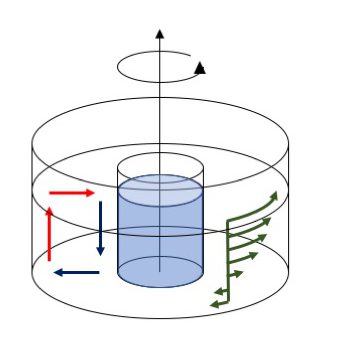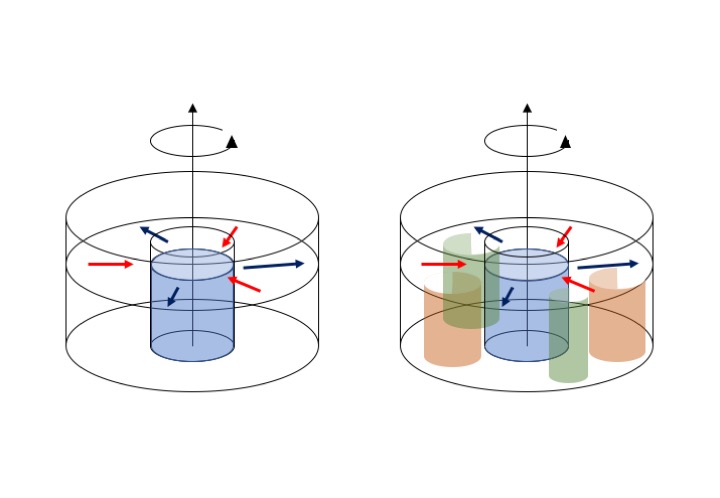
Combining rotation of a water tank with a temperature gradient: A Hadley cell circulation demo!
Yesterday, we combined a thermally-driven overturning circulation with the effects of rotation, and thus created a Hadley cell circulation. And while the tank was turning faster than we would have liked, we still managed to create a circulation that largely resembles the sketch below: An axially-symmetric overturning circulation (with cold water, indicated by blue arrows, moving down near the cooling in the middle and then outwards, and warmer water moving up along the outer rim and then towards the middle of the tank) which induces the thermal wind flow (sketched in green: Fast surface current in the direction of rotation but even faster than the tank is rotating, and slow bottom flow in the opposite direction).

But what would happen if we increased the tank’s rotation rate? It would make the induced azimuthal flow, the thermal wind, faster too, until it eventually becomes unstable and breaks down into eddies. And then, the experiment (first blogged about a long time ago) looks similar to this one: Lots and lots of eddies that are now rigid vertically and move as Taylor columns!
Heat exchange between the cold core and the warmer areas towards the rim of the tank now doesn’t happen via overturning any more, but looks something like sketched below: We now have radial currents bringing warm water towards the middle (red) and cold water away from it (blue), and the eddies that create those currents are coherent over the whole depth of the tank.

This is actually a really nice demonstration of the circulation in mid- and high latitudes where the weather is determined by baroclinic instabilities, i.e. weather systems just like the eddies we are showing here.
Btw, having two different experiments both represent the same Hadley cell circulation isn’t a contradiction in itself: On Earth, the Coriolis parameter changes with latitude, but in the tank, the Coriolis parameter is the same throughout the tank. So depending on what latitude we want to represent, we need to change the tank’s rotation rate.
Here is an (old) movie of the experiment, and I can’t wait for our own tanks to be ready to produce a new one!
Baroclinic instabilities / Hadley cell circulation in a tank | Dr. Mirjam S. Glessmer says:
[…] one experiment that we have been using as test case in all our previous sessions is the Baroclinic Instability / Hadley cell circulation. There are sketches of the setup and the expected circulation in this blogpost, so just a quick […]